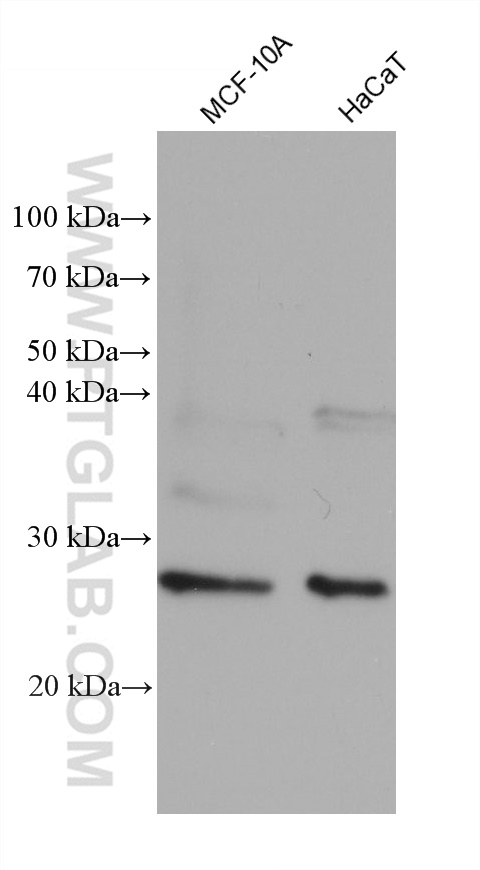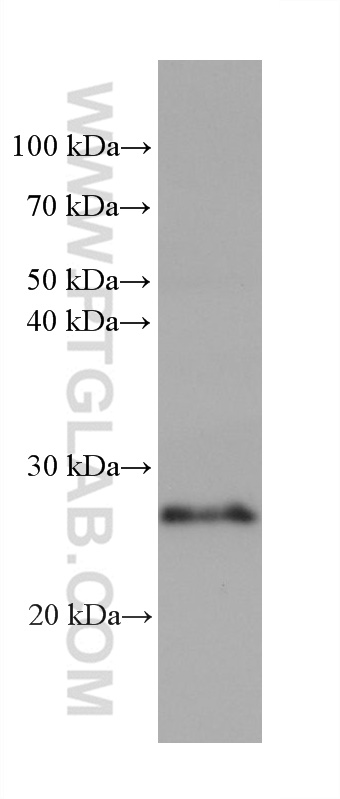验证数据展示
经过测试的应用
| Positive WB detected in | MCF-10A cells, Mo7e cells, HaCaT cells |
推荐稀释比
| 应用 | 推荐稀释比 |
|---|---|
| Western Blot (WB) | WB : 1:2000-1:10000 |
| It is recommended that this reagent should be titrated in each testing system to obtain optimal results. | |
| Sample-dependent, Check data in validation data gallery. | |
产品信息
68603-1-Ig targets RAB38 in WB, ELISA applications and shows reactivity with human samples.
| 经测试应用 | WB, ELISA Application Description |
| 经测试反应性 | human |
| 免疫原 |
CatNo: Ag26440 Product name: Recombinant human RAB38 protein Source: e coli.-derived, PET28a Tag: 6*His Domain: 1-211 aa of BC015808 Sequence: MQAPHKEHLYKLLVIGDLGVGKTSIIKRYVHQNFSSHYRATIGVDFALKVLHWDPETVVRLQLWDIAGQERFGNMTRVYYREAMGAFIVFDVTRPATFEAVAKWKNDLDSKLSLPNGKPVSVVLLANKCDQGKDVLMNNGLKMDQFCKEHGFVGWFETSAKENINIDEASRCLVKHILANECDLMESIEPDVVKPHLTSTKVASCSGCAKS 种属同源性预测 |
| 宿主/亚型 | Mouse / IgG2a |
| 抗体类别 | Monoclonal |
| 产品类型 | Antibody |
| 全称 | RAB38, member RAS oncogene family |
| 别名 | 3A10C5, Melanoma antigen NY MEL 1, RAB 38, Ras related protein Rab 38, Ras-related protein Rab-38 |
| 计算分子量 | 211 aa, 24 kDa |
| 观测分子量 | 24 kDa |
| GenBank蛋白编号 | BC015808 |
| 基因名称 | RAB38 |
| Gene ID (NCBI) | 23682 |
| RRID | AB_3085299 |
| 偶联类型 | Unconjugated |
| 形式 | Liquid |
| 纯化方式 | Protein A purification |
| UNIPROT ID | P57729 |
| 储存缓冲液 | PBS with 0.02% sodium azide and 50% glycerol, pH 7.3. |
| 储存条件 | Store at -20°C. Stable for one year after shipment. Aliquoting is unnecessary for -20oC storage. |
背景介绍
The RAB family of small GTPases is part of the Ras protein superfamily and is primarily responsible for regulating intracellular vesicle transport and migration. RAB38 is a recently identified member of the RAB family of proteins and its expression is tissue-specific. RAB38 is predominantly expressed in melanocytes and melanoma tissues, but not in other normal tissues, serving as a melanocyte differentiation antigen. RAB38 has also been reported to be upregulated in glioblastoma, and high levels of its expression are associated with a poor prognosis and enhanced cell migration.
实验方案
| Product Specific Protocols | |
|---|---|
| WB protocol for RAB38 antibody 68603-1-Ig | Download protocol |
| Standard Protocols | |
|---|---|
| Click here to view our Standard Protocols |



